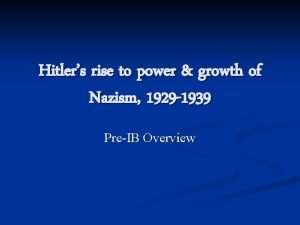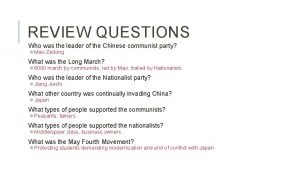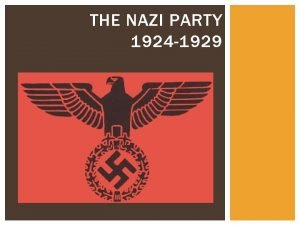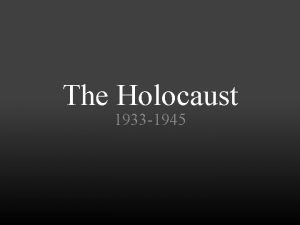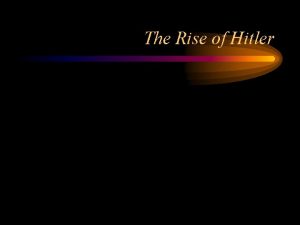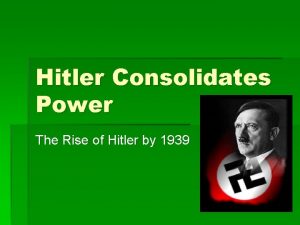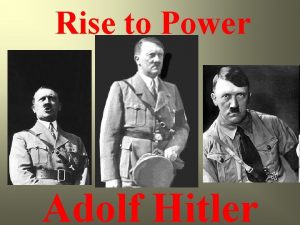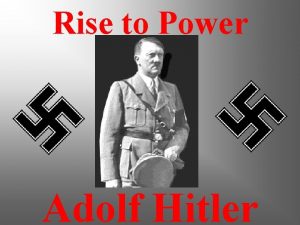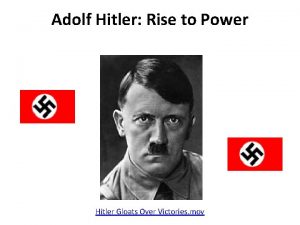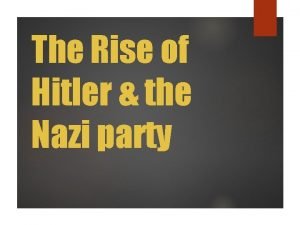Rise to Power Hitler Mao Rise to Power










- Slides: 10

Rise to Power Hitler- Mao

Rise to Power: historical context Hitler WWI ´s impact: the Treaty of Versailles; reparations, economic situation& problems, The Ruhr cirisis of 1932, humiliation The Weimar constitution: weaknessess and political instability; threats form the left (Spartacists, 1929)and right ( Kapp Putsch, 1920) Mao The Chinese Revolution of 1911; a republic Guomingtang against the Communist Party The Long March, 193435; the civil war and the struggle for power Hatred for western powers, imperialism

Historical context Hitler The period between 1924 -29: the Munich Putsch; Hitler´s imprisonment ; Mein Kampf ( by Kershaw Hitler like on holiday at a fancy hotel); tightening the party discipline Mao The Long March, the code Weaknesses of the Guomingtang

Hitler The Wall Street Crash and its impact, 1929 -33: economic collapse and insecurity Weaknesses of the grand coalition government: proportional representation Mao WWII and the Japanese impact, the civil war 1945 -49 Soviet Union and USA organised a meeting to prevent civil war taking place: Guomintang´s claims on Manchuria PLA ( Lin Biao): experienced in guerilla warfare, Soviet training

Hitler The rise of the Nazi party: in 1930 - 107 seats, in 1932 - 230 seats ( 37. 2 %). 1932 Nov. - 196. The role of the SA, SS The threat of communism: helped the Nazis ( social democrats did not cooperate with the communists) Guomingtang weaknesses; 10 years´ experience of running a one-party state; used police, army and harsh methods, corruption, poor military strategy

Hitler invited to the government ( last chancellors Papen, Schleichner) by Hindenburg New elections called up; massive propaganda, Reichstag Fire 27. 2. 1933/ Emergency degree, Article 48. the Nazis won 43. 9 % of the votes, with the help of the Catholic Centre Party NEW Ideology: Maoism; key elements - Importance of the peasants - Two-stage, continous revolution - Mass mobilisation and voluntaryism - Self-criticism, rectification, determination, primacy of MAO thought

Hitler The Enabling Act of 1933: Hitler given dictatorship for 4 years - All other parties forbidden - No trade unions - No elections - Gleichschaltung nazification Mao´s victory speech on 1 October, 1949 from the Gate of Heavenly of Beijing, Jiang Jieshi fled to Taiwan

The role of leader Hitler Personal sacrifice, charisma Ideology; Mein Kampf Control of police, Gestapo, SS All reaching propaganda machine Ability ot recruit other manipulative person Ability recruit other able people into the party and work for the communist goals, inspired the masses, loyalty, loved the peasants Ideology very clear and easy to adapt Personal charisma, enthusiasm

Hitler Ability to please different social, political groups Perfect timing! Perfect timing: civil war, WWII, took advantage of the weaknesses of the Guomingtang

Elimination of opposition The Night of the long Knives, 1934, SA Erich Röhm Trade unions, all other parties forbidden Civil service Law, 1933 Death of Hindenburg, 1934 Zhang Guotao, 1934 ( disagreements dealing with the route of the Long March) Rao Rashi, Gao Gang, 1949 Campaigns against the reactionary, feudal, capitalists and other bad elements launched in 1949

